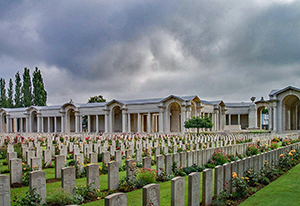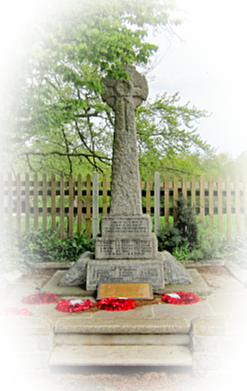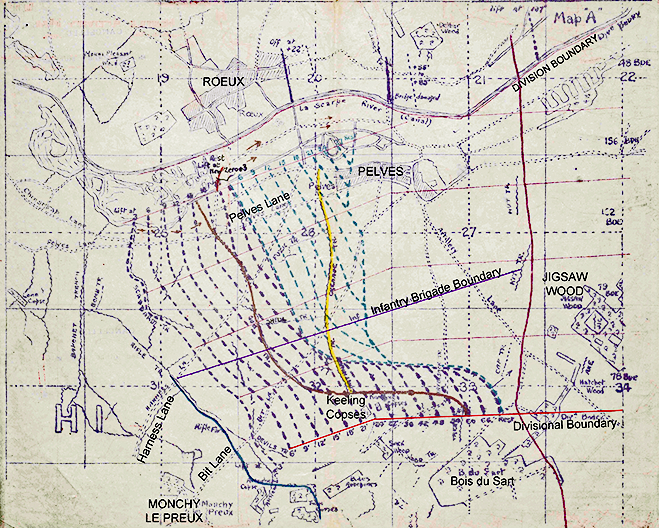First World War Project
Amos John BROWN (of Lynsted)
b. Q2, 1882 Private, Service Number G/13126 |

Born in Lynsted in the second quarter of 1882 and christened on 7 June 1882 in Teynham Church, Amos was the son of James Edward Brown, a brickfield labourer, and Emily Brown (née Jarrett). Both parents came from Teynham but lived in 8 Albion Place, Greenstreet, Lynsted. Amos had two older siblings, George and Annie (who predeceased Amos in 1916), and six younger siblings, Laura, Emily, Mildred, James, Harry and Charles.
At the time of his enlistment in Sittingbourne, on 29 February 1916, Amos was nearing 34 years of age and working as a chalk quarryman. Unusually for the time, Amos was 5 feet 11½ inches tall, well above the average height for the time.
Having been placed in the Army Reserve from 1 March 1916, Amos was mobilised on 21 August 1916 as Private, 4/5178, 3/4th (Reserve) Battalion, The Buffs (East Kent Regiment). On 3 September 1916 he was transferred to the 4th (Reserve) Battalion of The Buffs. His service records show that he sailed for France on 30 December 1916 and was recorded as being in the 3rd (Reserve) Battalion, The Buffs. On arrival in France on 31 December 1916, Amos was stationed in Étaples, the largest British military base on foreign soil, as part of the 6th (Service) Battalion in which he would remain for his short service. He was now Private G/13126.
From this point Amos's story coincides with that of Reginald Douglas Weaver who served in the same Battalion and died on the same day.
Shared Story
The winter of 1916/17 was notoriously hard, with heavy snowfall and hard frosts making conditions extremely unpleasant. The beginning of January 1917 saw Amos and Reginald's battalion training before leaving by bus towards Arras. In the period to the end of March 1917 the Battalion moved between billets in Montenescourt, Noyelette, Agnez Duisins and Lattre St Quentin, all west of Arras. Time was also spent at Givenchy le Noble, where they were given special training in practice trenches. On 10 March, the Battalion headed to Arras, which was under considerable enemy bombardment.
In preparation for Sir Douglas Haig's Spring Offensive, there was much work being undertaken to enlarge and dig new caves which would provide cover for thousands of massing troops and for the people of the town to take refuge. Electric lights were installed and the caves linked by tunnels to the front line.
On 5 April, the Battalion launched the most prolonged and furious bombardment on the enemy trenches - the largest bombardment so far of the war. The Battalion's War Diary for 9 April 1917, ominously starts "Zero Day" and was the first day of The Battle of Arras, and, in this case, the First Battle of the Scarpe.
The War Diary has been referenced by Colonel R S H Moody in his "Historical Records of The Buffs East Kent Regiment 1914-1919", an extract of which is documented below:
The Brigade was all formed up in the reserve trenches by 3.30am. The 6th Queen's were in first line on the right and the 7th East Surrey on the left. The 13th Liverpool Regiment of the division was on the right of the Queen's, who had The Buffs in support; while the 6th Royal West Kent supported the East Surreys. At 5.30am, the zero hour, the guns opened an intensive fire on the German Lines and at the same time the whole moved forward to the attack in artillery formation. The Buffs had C Company on the right and D on the left, with A, plus one and a half platoons of B, as the right support, and the remainder of B left support. After passing through the Queen's the first objective (Black Line) was reached and quickly captured by The Buffs, without much loss. A two hours' bombardment of the enemy's second system of trenches (Blue Line) followed, and then the barrage lifted and the advance was resumed. More opposition was now encountered, snipers and machine guns being active in both flanks. After stiff hand-to-hand fighting D Company was able to get round the flank and, by overcoming concealed machine guns, which the enemy had pushed forward into shell holes, reached and captured the point on the Blue Line which was its objective. C Company on the right was troubled by enfilade machine-gun fire operating on its right flank from the ruins of Estaminet Corner. By means of Lewis-gun fire and rifle grenading, however, these were eventually silenced and the company enabled to proceed. The Blue Line was consolidated, Lewis guns pushed forward and strong points dug. By 2.18pm the 35th Brigade came up, passed through the 37th and pushed on to the final objective. The whole attack made on this day was entirely successful, even more so than expected. Great numbers of prisoners, machine guns, field guns and material fell to The Buffs. All objectives were seized and consolidated and advance parties sent forward. By the afternoon no enemy was to be found except dead or prisoners in the "cages" or wired-in enclosure erected for the captured. On the 10th the cavalry went through and reached Monchy le Preux, where the battalion followed that night, having lost during the first Battle of the Scarpe 2nd Lieuts R G K Money and T W Buss and 23 men killed; Captain Gordon, 2nd Lieuts Wilks, Good, Figgis, Thornley, Squire and Baldwin, and 149 men wounded and 18 missing.
The next few days saw little relief. The Buffs were eventually relieved on 11 April and spent the day clearing up the battlefield, forming tool dumps and burying the dead. The news came that they would relieve the 37th Division but, due to white-out conditions, could not move. Relief came at nightfall the next day and they marched back to Arras. After a short rest they marched to billets at Montenescourt, accompanied by their band playing the regimental march. The last two weeks of Amos and Reginald's lives were spent marching between billets and undertaking more training in torrential rain.
The Third Battle of the Scarpe would be Amos and Reginald's next - and last - time at the front. In the very early hours of 2 May, their Battalion had completed the relief of the 7th Norfolks at Monchy. After dark that day, the 7th Battalion East Surreys took over the trenches occupied by the Battalion, who moved forward into position in shell holes. Orders arrived for a general attack the following morning with the objectives of taking Devils Trench and Keeling Copse. Zero hour was set for 3.45am.
The War Diary Report details Amos and Reginald's Battalion's actions on 3 May:
Monchy - 3rd May
At Zero hour an intense barrage opened up and a creeping barrage opened at a rate of 100 yds per 3 mins. The Battalion went over at the same time. The Signal Officer, 2nd Lieut McCaulay with 2 Signallers and 4 Orderlies went forward to establish an Advanced Battalion Headquarters in Devils Trench. No communication being possible, they returned at about 4.30pm. Two prisoners had already been sent down and apparently the Battalion had gone forward but in the darkness it was impossible to ascertain anything definite. Owing to sniper and Lewis Gun fire it was difficult to obtain any information as to how events were proceeding during the day.Acting Captain McDermott and Acting Captain Kitchin became casualties early in the day (the latter dying of wounds the following day). During the day except for continuous sniping and sudden bursts of artillery fire it was fairly quiet. A hostile aeroplane was brought down by our Lewis Gun fire in the afternoon. At dusk it was ascertained that the Battalion had suffered severe casualties amongst Officers and Other Ranks and that the line held was practically as before.
2nd Lieuts Seago and Sowter were sent for from the details camp and arrived about 10.00pm. These officers were sent forward to reorganise what remained of the Battalion.
The attack in the flanks was unsuccessful and it was afterwards found that 2 officers - 2/Lts Cocherane and Gunter with about 40 men had worked forward in the dark and had established themselves in a position North East of Keeling Copse with a Lewis Gun. They were able to account for a considerable number of Germans. After dark having expended every cartridge and bomb they
possessed, they cut their way back through 3 lines of German trenches. The 2 Officers with 13 men returned finally to Battalion Headquarters.
| 2/Lt Williams H W | Wounded | Lieut (Acting Captain) McDermott WK | Wounded |
| 2/Lt Warmington C | Missing | 2/Lieut Nesbit C H F | Wounded |
| 2/Lt Kirkpatrick A | Missing | 2/Lieut Grant A E | Missing |
| 2/Lt Dinsmore J H | Killed in action | 2/Lieut James K L | Missing |
| Lt (Acting Captain) Kitchin J B | Wounded (since died) | 2/Lieut Willis J H S | Missing |
| 2/Lt Evans H W | Missing | 2/Lieut King E A | Missing |
| 2/Lt Forster R L F | Missing | 2/Lieut Hardy-Mason H V | Killed in action |
With 360 Other Ranks |
|||
A further attack by the 6th Royal West Kent Regiment was made at 9.45pm to establish posts west of Keeling Copse.
This attack did not succeed.
What remained of the Battalion was relieved by 2.00am the following morning. The surviving members of the battalion who were not wounded retired to Arras to rest for just 2 days before returning to the trenches for a further ten days and relieved on 17 May.
The Battalion suffered at least 376 casualties, the combination of killed, wounded and missing on 3 May. Initially 207 men were reported as missing; many were later found to have lost their lives.
Amos and Reginald were among those initially posted as missing. Almost a year later, on 3 April 1918, it was made official that it was assumed they died "on or after" 3 May 1917. Their service in France had lasted 123 days.
The Commonwealth War Graves Commission records 131 men of the battalion eventually confirmed as having lost their lives on 3 May 1917. Of those lost, only 6 have known graves. The others, including Amos and Reginald, are all listed together on Bay 2 of the Arras Memorial.
Amos and Reginald were both posthumously awarded the British War and Victory medals. [See Appendix 1]
Amos's mother received his money owed in October 1918. This amounted to £4 4s 0d (£4.20p). In October 1919 she also received his War Gratuity of £3. [See Appendix 2] Taken together these amount to roughly £415 in today's money.
Reginald's father received £5 5s 11d (£5.29½p) in owed pay in May 1918. Also his war gratuity of £8 10s 0d (£8.50p) in October 1919. Taken together these amount to roughly £760 in today's money.
Reginald is also commemorated on the Hollingbourne War Memorial, the village of his birth, and on their Roll of Honour in All Saints Church.
Creekside Cluster Losses on 3rd May 1917
Thursday 3 May 1917 saw the heaviest casualties for Lynsted when 5 men were lost at the Third Battle of the Scarpe.
 The stories of these 5 men follow similar paths. Amos Brown and Reginald Weaver both served in 6th (Service) Battalion, The Buffs (East Kent Regiment). Stanley Cleaver and MacDonald Dixon served in both the Royal East Kent Yeomanry (The Duke of Connaught's Own) (Mounted Rifles) and 7th (Service) Battalion, The Buffs (East Kent Regiment). William Gambrill served in both Royal East Kent Yeomanry (The Duke of Connaught's Own) (Mounted Rifles) and the Household Battalion, Household Cavalry and Cavalry of the Line, alongside Henry Carrier who was lost 8 days later on on 11 May 1917.
The stories of these 5 men follow similar paths. Amos Brown and Reginald Weaver both served in 6th (Service) Battalion, The Buffs (East Kent Regiment). Stanley Cleaver and MacDonald Dixon served in both the Royal East Kent Yeomanry (The Duke of Connaught's Own) (Mounted Rifles) and 7th (Service) Battalion, The Buffs (East Kent Regiment). William Gambrill served in both Royal East Kent Yeomanry (The Duke of Connaught's Own) (Mounted Rifles) and the Household Battalion, Household Cavalry and Cavalry of the Line, alongside Henry Carrier who was lost 8 days later on on 11 May 1917.
Three more men were lost that day from the Creekside Cluster. Harry Filmer, lost from Newnham, served in the 1st (Service) Battalion, The Buffs (East Kent Regiment). William Henry Laker, lost from Teynham, served alongside Stanley Cleaver and MacDonald Dixon serving in 7th (Service) Battalion, The Buffs (East Kent Regiment). George Potts, also lost from Teynham, served alongside Amos Brown and Reginald Weaver, 6th (Service) Battalion, The Buffs (East Kent Regiment).
Six of these eight men fell without a known grave and are recorded in Bay 2 of the Arras Memorial alongside 242 other men from The Buffs who perished that day. They are Amos John Brown, Stanley Monkton Cleaver, MacDonald Dixon, William Henry Laker, George Potts and Reginald Douglas Weaver.


 World War 1 Pages
World War 1 Pages